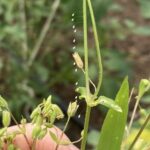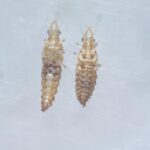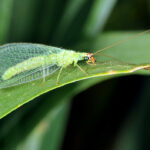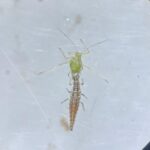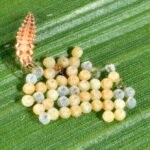Lacewings are a group of insects commonly found in Indiana and throughout the world. There are several species, but the most common that you will see in Indiana include the green lacewing and the brown lacewing. They belong to a unique order of insects, Neuroptera, and are commonly referred to as aphid lions. The life cycle of lacewings consists of four stages. First is the egg stage; they are oval shaped with a pale green color and are deposited atop a silk stalk (Fig. 1). This is to protect them from predators and eating one another when they hatch! The larvae emerge around five days after the egg is laid. The larvae are recognizable by their grey to brown long segmented body and large pincer-like mouthparts (Fig. 2). The larval stage lasts two-three weeks, during which time they look the same but get progressively larger. The larvae then form a silken cocoon in which they stay for 10-14 days while resting and transforming into an adult. The adults are easily recognizable by their big lacey wings (transparent or brown), long antennae, and 12-20 mm long soft body (Fig. 3)
- Figure 1: Lacewing eggs deposited on silk stalk (Photo by S. Willden).
- Figure 2: Lacewings larval stage (Photo by Cristhian Ochoa).
- Figure 3: Lacewing adult specimen (Photo by John Obermeyer).
Lacewings play an important role in our agricultural ecosystems. While the adults mainly feed on pollen or nectar, the larval stages are voracious predators that use their long mouthparts to capture and feed on small soft-bodied insects (Fig. 4). It is this trait, and our ability to rear them, that has made lacewings a viable augmentative biological control option. We often use lacewing larvae for aphid management, as they have the capacity to eat around 200-400 aphids in their larval stage. Lacewings are also effective at controlling mealybugs, leafhoppers, spider mites and other pests (Fig. 5).
- Figure 4: Lacewing larva eating an aphid (Photo by Cristhian Ochoa).
- Figure 5: Lacewing larva eating western been cutworm eggs (Photo by John Obermeyer).
You can find lacewings naturally in early spring and they will disperse and breed throughout the summer. In winter they prefer to stay as cocoons or in some cases as adults, so you might not be able to see any lacewing larvae in your overwintering crops. However, recent studies have shown that lacewings are an effective aphid predator for winter season crops in high tunnels, making them a viable option to purchase and augment in these systems.
Naturally occurring lacewings can be attracted to crops by providing floral resources that will recruit adults, who will then lay eggs near prey populations. Lacewings can also be purchased and released in a crop for augmentative pest management. They can be purchased as eggs, larvae or adults, but to choose one, you will have to consider the purpose of your application. Eggs are easy to disperse but they take some time to hatch which makes them the best choice for preventive applications. On the other hand, purchasing larvae is a better option for immediate pest suppression but it is more expensive, and you would have to apply them upon receipt because the larvae eat each other. Purchasing them as adults would take longer to have a predation response, you would have to wait for them until they start laying eggs and those eggs hatch, adults are not predators so their only advantage is that they can disperse by themselves because of their flying behavior.
